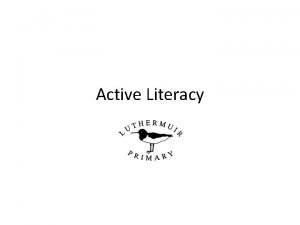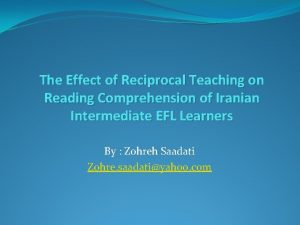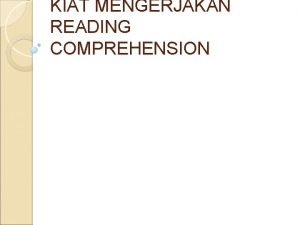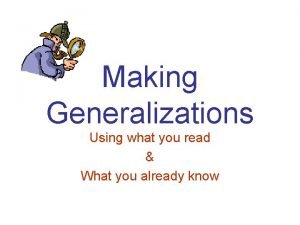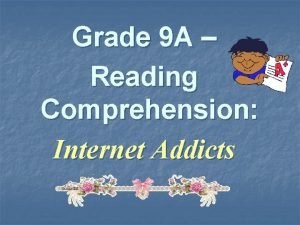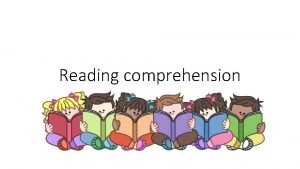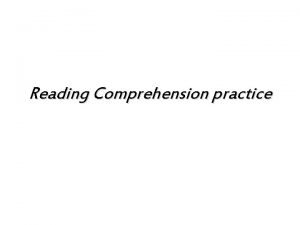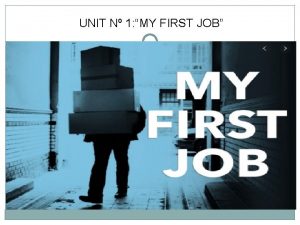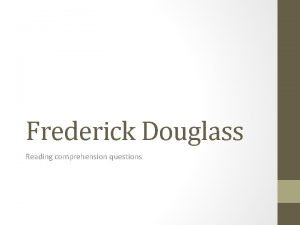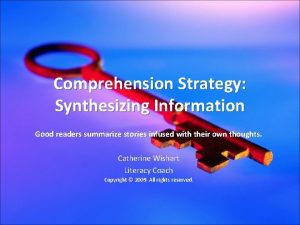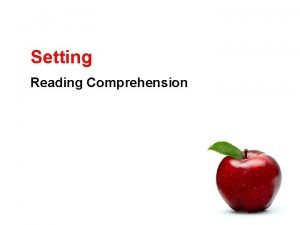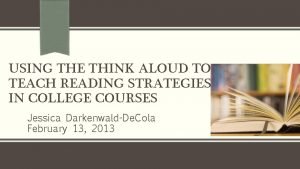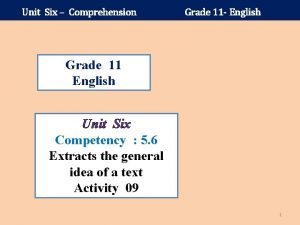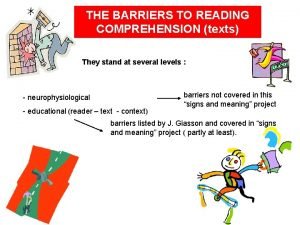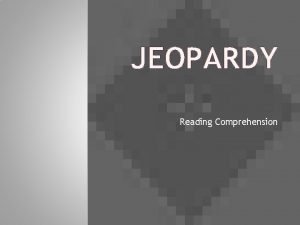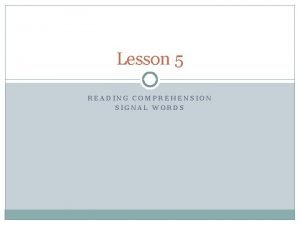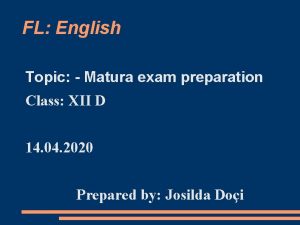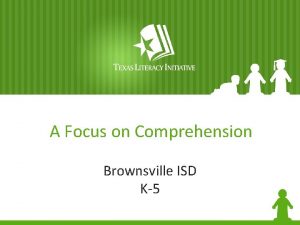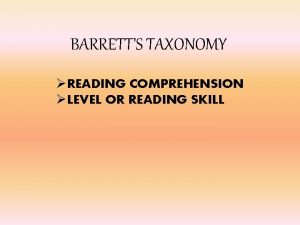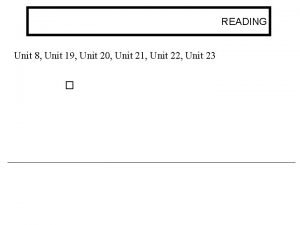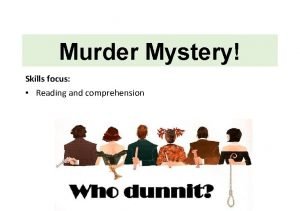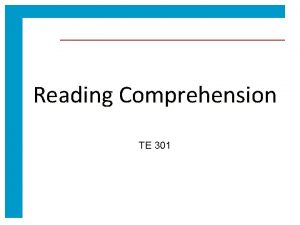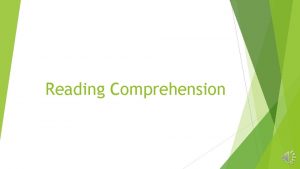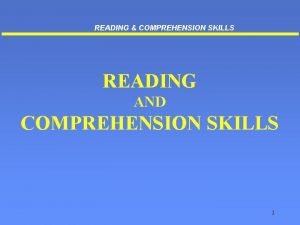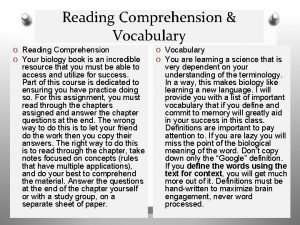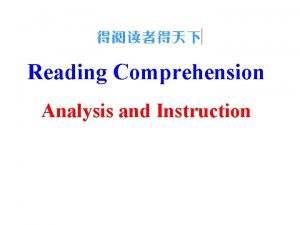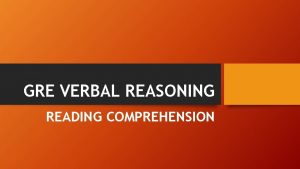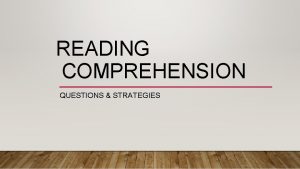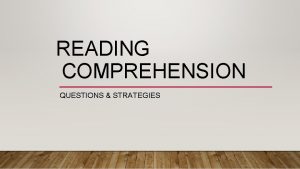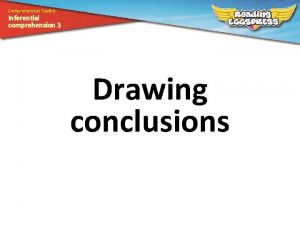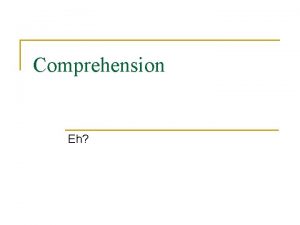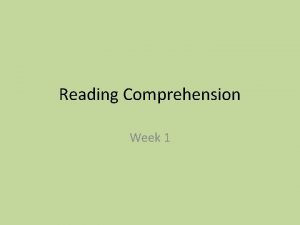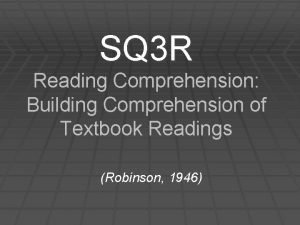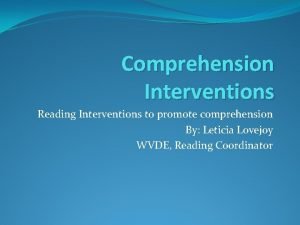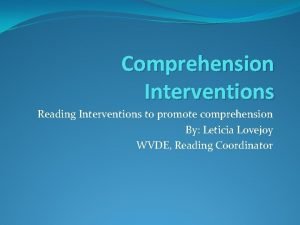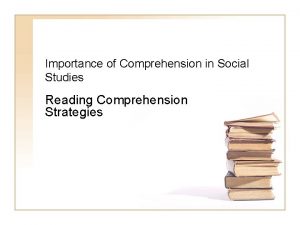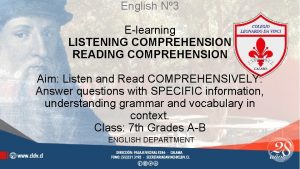Reading Comprehension TE 301 What is Comprehension In



























- Slides: 27

Reading Comprehension TE 301

What is Comprehension • In small groups, come up with a definition for reading comprehension • Consider the following in your definition: – What does it mean to have reading comprehension? – What other literacy domains affect comprehension? – How does one tell if a student is comprehending what he or she is reading?

One Definition of Comprehension • The ability to utilize lower order reading processes (including decoding and vocabulary knowledge) and higher order reading processes (including relation of text content to schema and conscious controllable processing) to understand concepts and ideas from text (Pressley, 2000*) *see references section for full citations

Comprehension Further Defined • “The process of simultaneously extracting and constructing meaning through interaction and involvement with written language” (Rand Reading Study Group, 2002, p. xiii) Reader Text Meaning

Comprehension Model • Reliant upon: – Reader factors-what readers bring to the reading process, including purpose, motivation and strategies they use to read – Text factors-author’s ideas, words used, organization and presentation of ideas – Activity or the purpose and task behind the reading Reader Activity Text Rand Reading Study Group, 2002

Plasmon Resonance Quick Write • Read the journal article individually and consider the following: – What were the key things the authors were trying to convey to the readers in the introduction and conclusion of the Plasmon Resonance reading? – What do you view as the key points to “take away” from the reading, if any? – What questions were you left with after the reading? • Write your response on an individual sheet

Influences at Work • Trade your quick write with a partner • Based on this quick write, did your partner “comprehend” the Plasmon Resonance article? • In what ways did they comprehend it? • How do you know? • Which factors were influencing your comprehension (vocabulary, decoding, prior knowledge, or others)? • What strategies did you use to try to comprehend the text?

Factors Influencing Comprehension • Word Level Processes – Decoding • Less effort to decode means more effort put toward comprehension • Skilled comprehenders can recognize when a word is missed because it “doesn’t make sense” – Vocabulary • More extensive vocabulary promotes comprehension • If the reader “knows” the word, reader spends less time figuring out individual words and more time available for general comprehension Pressley, 2000

Factors Influencing Comprehension • Processes Above Word Level – Prior Knowledge • Draw on schemas to aid in comprehension • Use inferences from schema to help comprehend text – Controlled Processing • Use a variety of processes to help make meaning of text, including being aware of purpose for reading, getting an overview of the text, predicting what the text is about, reading selectively, questioning, imagining, clarifying, revising or integrating prior knowledge, figuring out meanings of new words, interpreting text, evaluating quality and reviewing the text after reading Pressley, 2000

Strategies good readers use? • Use a variety of strategies before, during, and after reading – Predict – Question – Imagine – Clarify – Summarize – Make inferences – Integrate prior knowledge Pressley & Hilden, 2004

Other Factors • In addition to vocabulary, phonological processing, decoding, and prior knowledge, other factors can affect comprehension including: – Oral language – Fluency – Short-term/Working memory – Motivation – Type of text (genre and other text factors)

Influence of Oral Language • We need more research about the relationship between oral language and comprehension, but it makes sense to assess oral language skills of children who are struggling with comprehension

The Role of Fluency • When students read fluently (at an appropriate pace, accurately, and with good prosody) it indicates higher word recognition levels, in turn freeing up cognitive attention to comprehension • Use of prosody also helps the reader to comprehend and reflects comprehension of the text that is read Duke, Pressley, & Hilden, 2004

Short-term or Working Memory • Some research suggests that a student’s shortterm or working memory may not have the same capacity as those who do not struggle with comprehension • The student may simply not be able “to hold” what is read in the short-term memory • What does it feel like to not have short-term memory capacity? Duke, Pressley, & Hilden, 2004

Motivation • The Expectancy x Value framework • Readers who are struggling with comprehension are less likely to want to read • The less students read, the less practice they have to engage in comprehension strategies, exposure to new vocabulary words, and the opportunity to develop fluency. Duke, Pressley, & Hilden, 2004

Type of Text: Linear vs. Hypertext • What differences can you think of between linear (printed text) and hypertext (electronic text)? • What similarities exist? • How does comprehension change from linear to hypertext?

Comprehension of Hypertext • Strategies employed include: – Relying on prior knowledge • • – – – Of the topic Of the text structures Of structures of informational websites Of search engines on the web (to plan, predict, monitor and evaluate subsequent text) Setting purpose Reviewing and predicting Finding main ideas Minimizing disorientation Evaluating text • Using literal matching skills (did I find what I wanted to find? ) • Based on structural and context clues (often to make inferences about the text) Coiro & Dobler, 2007; Duke, Schmar-Dobler, & Zhang, 2006

What don’t you get? Consider this • Traditional skilled use read within text about comprehension great deal about known is readers as they environments read. • A great deal is known about the comprehension strategies that skilled readers use as they read within traditional text environments (text from pg. 214 of Coiro and Dobler, 2007)

What don’t you get? • Why some kids have difficulties in comprehension – Meaning is not constructed from the individual words – Comprehension goes beyond the ability to read fluently and/or recognize words – Any number of issues can affect comprehension and these can occur for text, reader, and/or activity

Ruling Out • Is the student having issues with word decoding or recognition (sight words)? • Is the student having issues with fluency? • What do you know about the student’s oral language? • Is short-term or working memory an issue? • How is the student’s primary language related to the language of the text? • Is the issue related to an unfamiliarity with specific features or aspects of written language? • What strategies, if any, is the student using? • How motivated is the student (for the material or the activity? ) Duke, Pressley, & Hilden, 2004

Comprehension Struggles: Beyond Not Getting It • Variations in issues with children who are struggling to comprehend: – Automatic word callers: good fluency, poor comprehension – Struggling word callers: some difficulty in word ID, though still stronger in fluency and word ID than meaning – Word stumblers: difficulty with word ID, but relatively strong in determining meaning – Slow and steady comprehenders: read slowly, but strong word ID and comprehension – Slow word callers: accurate yet slow in reading, poor comprehension – Disabled readers: difficulty in both word ID and comprehension Buly & Valencia, 2002

What This Tells Us • Have to look beyond test scores • Triangulate your data – Formal assessments – Informal assessments • Determine if multiple causes might be at work (which is true in many cases) • Determine where the issue begins, rather than just looking at the end (comprehension) • Determine what the best course for instruction is based on the various causes (and what you can or can’t address)

Assessments Available • Concepts of Comprehension Assessment (COCA) • Cloze Test: Mc. Kenna and Stahl page 179 • San Diego Quick Assessment Form I: Mc. Kenna and Stahl page 180 -185

Informal Assessment • Retelling • Summarization • Observations during class discussions or reading groups • Graphic organizers • Journal entries • Listening and reading comprehension • Qualitative Reading Inventory (QRI)

Formal Assessment • Cloze Assessments (fill in the blank) • Reading basal assessment (but note that not all of these assessments are standardized) • Comprehension subtest as part of other standardizes tests • Diagnostic Assessments of Reading, Gates-Mac. Ginitie, Qualitative Reading Inventory (QRI), Brigance, Metropolitan Achievement Test, Michigan Literacy Progress Profile [MLPP], etc. )

What can teachers do? • Model effective comprehension strategies • Scaffold effective comprehension strategies • Give kids time to practice and to help develop comprehension skills • Choose appropriate books for the classroom library and reading groups • Encourage the use of authentic text • Use a variety of genres • Write texts for others • Talk about texts and contexts • Give students time to read Duke & Pearson, 2002; Pressley, 2000

References • • Coiro, J. , & Dobler, E. (2007). Exploring the online reading comprehension strategies used by sixth-grade skilled readers to search for and locate information on the Internet. Reading Research Quarterly, 42, (2), 214 -257. Duke, N. K. , Schmar-Dobler, E. , & Zhang, S. (2006). Comprehension and technology. In M. C. Mc. Kenna, L. D. Labbo, R. D. Kiefer, & D. Reinking (Eds. ), International Handbook of Literacy and Technology Volume II (pp. 317 -326). New York: Taylor & Francis Books, Inc. Duke, N. K. , Pressley, M. , & Hilden, K. (2004). Difficulties with reading comprehension. In C. A. Stone, E. R. Silliman, B. J. Ehren, & K. Apel (Eds. ), Handbook of Language and Literacy: Development and Disorders (pp. 501 -520). New York: Guilford Press. Duke, N. K. , & Pearson, P. D. (2002). Effective practices for developing reading comprehension. In A. E. Farstrup & S. J. Samuels (Eds. ), What research has to say about reading instruction (3 rd ed) (pp. 205 -242). Newark, DE: International Reading Association. Pressley, M. (2000). What should comprehension instruction be the instruction of? In M. L. Kamil, P. B. Mosenthal, P. D. Pearson, & R. Barr (Eds. ), Handbook of Reading Research, Volume III. (pp. 545561). Mahwah, NJ: Lawrence Erlbaum Associates, Inc. Pressley, M. & Hilden, K. (2004). Verbal protocols of reading. In N. K. Duke and M. H. Mallette (Eds. ), Literacy Research Methodologies (pp. 308 -321). New York: Guilford Press. RAND Reading Study Group. (2002). Reading for understanding: Towards and R&D program in reading comprehension. Santa Monica, CA: Rand Education. Riddle Buly, M. & Valencia, S. W. (2002). Below the bar: Profiles of students who fail state reading assessments. Educational Evaluation and Policy Analysis, 24, 213 -239.
 While reading activities
While reading activities Reading comprehension pyramid
Reading comprehension pyramid Reading comprehension meaning
Reading comprehension meaning Tersurat
Tersurat Making generalizations
Making generalizations Reading comprehension christmas traditions
Reading comprehension christmas traditions Are you an internet addict reading comprehension
Are you an internet addict reading comprehension The lost kitten reading passage
The lost kitten reading passage Birthday party reading comprehension
Birthday party reading comprehension My first job reading comprehension
My first job reading comprehension Headsprout reading comprehension
Headsprout reading comprehension Frederick douglass comprehension questions
Frederick douglass comprehension questions Super six reading strategies
Super six reading strategies Reading comprehension synthesizing
Reading comprehension synthesizing Setting of jake story
Setting of jake story What is the answer
What is the answer What is think aloud strategy
What is think aloud strategy Grade 11 comprehension questions and answers
Grade 11 comprehension questions and answers Reading barriers
Reading barriers Reading comprehension jeopardy
Reading comprehension jeopardy Agenda reading comprehension
Agenda reading comprehension Matura exam english
Matura exam english If i were you i would
If i were you i would K5 reading comprehension
K5 reading comprehension Unit 1 jobs
Unit 1 jobs Barrett's taxonomy of reading comprehension
Barrett's taxonomy of reading comprehension Reading comprehension
Reading comprehension Focus
Focus

